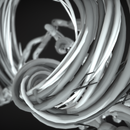Introduction: Slit Scan Turntable
"The slit-scan photography technique is a photographic and cinematographic process where a moveable slide, into which a slit has been cut, is inserted between the camera and the subject to be photographed." from wikipedia
Slit scan is a fascinating technique to create images distortions, a great way to use it is to combine the technique with a motorized turntable (also called lazy susan).
If you are interested in the slit scan techniques and all its variations check this resource: http://www.flong.com/texts/lists/slit_scan/
Step 1: Material Required
- Webcam, for instance Logitech C920 HD https://www.amazon.co.uk/gp/product/B006A2Q81M/ref...
- Computer
- Motorized lazy susan / rotating turn table https://www.amazon.co.uk/gp/product/B011BERSCG/re... , you might be interested building your own lazy susan
- lighting and background (optional)
Step 2: Download and Run the Software
If you are not planning to modify the application download directly the executable for the application (windows)
http://s000.tinyupload.com/?file_id=07847580458891268497
Or download the source code of the software https://github.com/paul-ferragut/timeSlicer and compile the application using openFrameworks and visual studio(windows) / xcode(OSX)
The application contains a file called settingsCamera.xml
You can open this file with a text editor and change the value for the webcam you are using. You can change the camera resolution or change the camera being used (eg: if you use an laptop with an embed camera set the camera to 0 and if you want to use an external USB HD camera set the camera ID to 1)
Step 3: Setup Your Slit Scan Stage
Choose objects to slit scan and place it on the turn table. Using a background will make the effect more interesting.
Launch the software and use the user interface to record frames from the slit scan, you can use the slider to choose to save every n frames.
You will be able find the screen shots in the app data folder.
Afterward you can use a video editing software to create a video from all the still images.
Share you slit scan experiments!
657 from Paul Ferragut on Vimeo.




